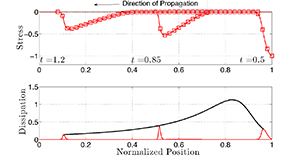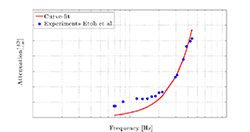![]() Wave Propagation through Soft Tissue
Wave Propagation through Soft Tissue
PI: Prof. Bala Balachandran
The interaction of blast waves with the human head involves propagation of nonlinear stress and strain waves within the brain, and this propagation is characterized by the transfer of a large amount of energy at high strain rates in a short time window. Experiments with swine and rat brain tissue subjected to tension, compression, and shear loads indicate that brain tissue behaves as a nonlinear visco-elastic material. A primary aim of this investigation is to gain a fundamental understanding of the influence of soft tissue nonlinear material properties on the propagation characteristics of stress waves generated by transient loadings. The soft tissue is modeled as a nonlinear visco-hyperelastic material; the geometry is assumed to be one-dimensional rod; and uniaxial propagation of longitudinal waves is considered.
The linearized system equations can be used to predict brain tissue material parameters through the use of available experimental ultrasonic attenuation curves. Furthermore, frequency thresholds for wave propagation along internal structures, such as axons in the white matter of the brain, have been obtained through the linearized model predictions.
Comparison between experimental measurements of attenuation in bovine brain tissue (Etoh et al., 1994) and linearized model predictions.

Stress saves steepening as they travel through the rod (top). Dissipation concentrated at the location of the steep wave fonts (bottom).
With the nonlinear material model used, the numerical results illustrate that one of the imprints of the nonlinearity on the wave propagation phenomenon is the steepening of the wave front, leading to jump-like variations in the stress wave profiles. This phenomenon occurs as a consequence of the dependence of the wave speed on the local deformation of the material. As per the predictions of the nonlinear material model, compressive waves in the structure travel faster than tensile waves. Furthermore, it is found that wave pulses with large amplitudes and small elapsed times are attenuated over shorter spans.
In addition, it is shown that when steep wave fronts are generated in the nonlinear viscoelastic material, energy dissipation is focused in those wave fronts implying deposition of energy in a highly localized region of the material.
Novel mechanisms for brain tissue damage are proposed based on the results obtained. The first mechanism is related to the dissipation of energy, which is highly localized at the wave front as it travels through the structure. The second mechanism is related to the interaction of steep wave fronts with axons encountered across its way through the brain. If the diameter of the axons is comparable with the space scale of the wave front (width of the wave pulse), then a differential stress will be rapidly applied to the axon.


